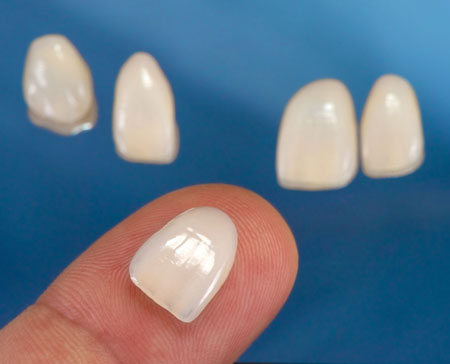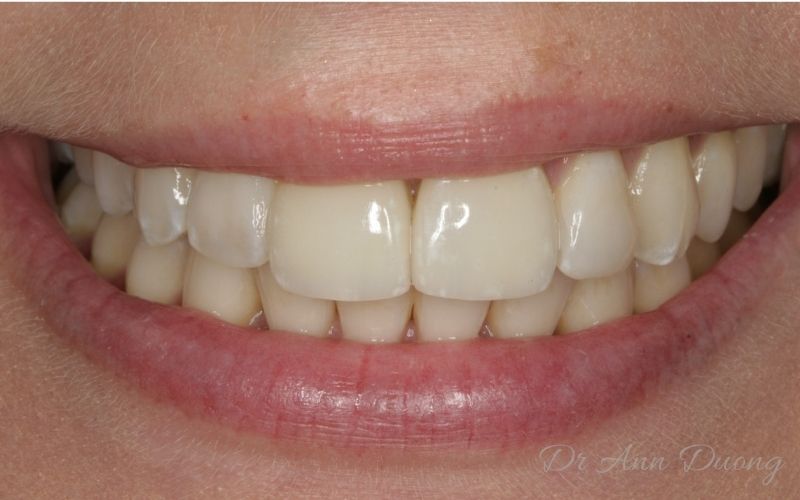Porcelain dental veneers are aesthetic restorations that may be offered as part of a cosmetic dentistry treatment plan. They are made of a thin facing of high-quality dental porcelain which is securely attached to the front surface of the tooth.
About Porcelain Veneers

- What Are Porcelain Veneers?
- What Are Veneers Used For?
- Porcelain Veneers Procedure
- Alternatives to Porcelain Veneers
- Advantages of Porcelain Veneers
- Disadvantages of Porcelain Veneers
- What Do Porcelain Veneers Look Like Before They're Bonded to Teeth?
- What Do Porcelain Veneers Look Like After They're Bonded to Teeth?
- Which Dentist Will Design and Fit My Veneers?
What Are Porcelain Dental Veneers?
In dentistry, porcelain veneers are referred to as “indirect restorations”. This means that they are made away from the tooth in a dental laboratory and are subsequently bonded onto the tooth.
In cosmetic dentistry, porcelain is the material of choice. Porcelain is able to closely replicate dental enamel.
Dental porcelain has improved vastly over the years. Older porcelain veneers often appeared too uniform, opaque or bulky. This could make them look unnatural.
At Preventive Dentistry, we use modern porcelain technologies and systems such as e.max veneers. These are thin, translucent and reflect light much like enamel. As a result, e.max veneers look natural and lifelike.
What Are Veneers Used For?
If you want to improve your teeth, porcelain dental veneers may be the solution for you. They are highly aesthetic restorations that can be used to achieve a variety of goals:
- They can change the shape and size of teeth:
- closing gaps between teeth
- lengthening teeth
- fixing chipped or broken teeth
- making naturally small teeth such as “peg laterals” larger
- They can change the colour of teeth. This may be particularly useful when there is tetracycline staining, which can often be very difficult to treat with whitening alone.
- They can make slightly crooked teeth more aligned and improve the symmetry of the teeth and smile.
Usually, several teeth are veneered as part of a treatment to achieve the desired result. Each tooth being treated needs to be meticulously prepared so that placement of the veneers looks natural.
Porcelain Veneers Procedure
As porcelain dental veneers are indirect restorations:
- the teeth first need to be prepared
- the veneers are then made by the dental lab
- and then the veneers are fitted to the teeth
So, a minimum of two appointments is required to place porcelain veneers.
We are passionate about giving you beautiful veneers that look the way you want them to and feel completely natural. Thus, a series of appointments are necessary. Everyone is different, and every treatment plan is different, so the number and length of appointments will vary.
Typically the sequence of steps are as follows:
Comprehensive Examination
- During this 50 minute appointment, you will meet with your dentist and discuss your concerns and the outcomes you would like to achieve. A thorough examination will follow to obtain as much information as possible to plan your veneers treatment.
- X-rays and clinical photographs will be taken.
- Your dentist will tell you whether veneers are suitable for you or whether there are alternative solutions. After this appointment, the dentist will then take the time to study your records and devise a personalised treatment plan.
Short Follow-Up Appointment
- A follow-up 20-minute appointment may be scheduled to go through your treatment plan and estimate of fees. If this appointment is required it will be free of charge. During this time, take the opportunity to further discuss with the dentist any questions you may have about the procedures.
Designing and Planning
- Once you've accepted your treatment plan, your dentist will design and plan your veneers. This starts with a more in-depth conversation about the appearance of your veneers.
- Impressions of your teeth are taken and a model is made on which the dental lab will sculpt the shape of your new teeth - a “diagnostic wax-up”. You'll be shown this wax-up and a mock-up may be transferred to your mouth so you can try in your new teeth. We may also use digital technology to show you how your veneers will look on you.
Preparing Your Teeth for Veneers
- This step requires a longer appointment. A local anaesthetic may be used to ensure your comfort.
- During this appointment, a thin layer of enamel is removed from the front of your teeth. Then accurate digital scans or impressions of the teeth will be taken.
- Your teeth may be covered with temporary veneers, shaped to look like the diagnostic wax-up.
Custom Making the Veneers
- The veneers are made at a highly specialised dental lab. There will be extensive communication between the dentist and the lab during this process. Photographic documentation is used to clearly communicate the desired appearance of each veneer.
The Try-in Appointment
- Once your veneers have been custom made, they are ready for trying in the mouth.
- If you are happy with the veneers they can be fitted to your teeth during this appointment.
- If your dentist suggests final adjustments (usually shade and characterisations), the veneers will be returned to the lab for this to occur. Do not be disappointed if this happens. Your veneers will be with you for a long time, so it is important to achieve the best finish possible. An extra week or two before getting your veneers will be well worth the wait! There will be no extra charge if adjustments are made to the veneers.
Fitting Your Veneers
- Once final finishing touches are made by the lab, your veneers will be fitted. Your temporary veneers will be removed and the porcelain veneers will be securely bonded to your teeth. This may be done under a local anaesthetic.
The Review Appointment
- At a subsequent appointment, your dentist will review your new veneers to ensure you feel comfortable with your new smile. Minor shape adjustments and polishing can be done, and post-op photos are taken.
Veneers Case Study
1. Veneers case study - before treatment

The central incisors are chipped and irregular.
2. Veneers case study - try-in appointment

The patient has had their teeth professionally whitened. The lateral incisors have undergone composite resin bonding.
Two veneers have been temporarily placed on the central incisors to check their fit and appearance.
3. Veneers case study - second try-in appointment

The dentist has made adjustments to the veneers. The outer corner of the left central incisor has been rounded and shortened.
4. Veneers case study - after treatment

More white flecks have been added at the dental laboratory to better match the natural teeth. The two veneers are now permanently bonded in place.
Alternatives to Porcelain Veneers
Composite Resin Bonding/Composite Resin Veneers
- These are “direct restorations” meaning that they are placed during one appointment by the dentist.
- During the procedure, the dentist will bond and hand sculpt the composite resin directly onto the teeth.
- It generally does not involve tooth preparation and is often done without local anaesthetic.
- Planning and wax-up stages may still be necessary.
- This option is less expensive than porcelain veneers but does not last as long. Composite resin is more prone to discolouration and chipping over time.
Dental Crowns
- If you have large fillings or large breaks or chips in your teeth, crowns may be more suitable than porcelain veneers.
- Crowns are able to cover and provide strength and protection to the whole tooth.
Whitening
- Some people may find that they are satisfied with the appearance of their teeth after a course of professional tooth whitening.
- Minor flaws in the shade and colour of the teeth may remain in some cases, especially in teeth that have been affected by
- fluorosis (white spots)
- tetracycline staining (dark banding)
Orthodontics
- When teeth are very crooked, it may be better to use orthodontics to move the teeth into ideal alignment.
Every treatment plan is fully customised to your needs. It is quite common to have a treatment plan which involves porcelain veneers as well as one or more of the above.
Advantages of Porcelain Veneers
- Completely customisable.
- Natural appearance: the thinness and translucency of the porcelain, and the way this material reflects light, allows for extremely realistic results.
- Porcelain is resistant to staining. The biggest advantage of porcelain veneers compared to composite resin bonding is that they don’t stain or discolour over time.
- Less invasive than crowns. Porcelain veneers involve less tooth preparation compared to crowns.
- A faster way to realign teeth than orthodontics.
Disadvantages of Porcelain Veneers
- Porcelain veneers are a long term commitment. Preparation involves the removal of some tooth enamel, which is permanent. No dental restoration lasts forever - once you have committed to having porcelain veneers, they will eventually need to be replaced. Porcelain veneers can last between 10-30 years.
- If they chip or crack, they will usually need to be removed and replaced.
- The colour can’t be altered once they are fitted.
- They cost more than composite resin veneers.
What Do Porcelain Veneers Look Like Before They're Bonded To Teeth??
Before they are bonded to teeth, veneers look like very thin porcelain facings.
Well-made porcelain veneers are never one shade or colour. They will be layered with several shades to mimic the way natural teeth look and will feature areas of translucency and opacity. The surface texture will have natural undulations that mimic the texture of real teeth. Their gloss and lustre will be made to match that of your teeth.
What Do Porcelain Veneers Look Like After They're Bonded To Teeth??
They will look like real teeth!
Well-made veneers look completely natural as if they are your own teeth. Due to the design and planning process at Preventive Dentistry, they will be made to be harmonious with your mouth, smile, and the whole of your face. No join lines are visible, the gums will look healthy and no one will know that you have porcelain veneers (unless you tell them!).
Which Dentist Will Design and Fit My Veneers?
Creating beautiful natural looking veneers involves experience, skill, science, and attention to detail. In order to achieve the teeth you want and will enjoy for years to come, you need a dentist with these qualities, who listens to your needs, and is committed to the process and final outcome.
Dr Ann Duong has a special interest in cosmetic dentistry and porcelain veneers, and she loves creating beautiful teeth and smiles. Dr Ann has attended numerous continuing education lectures and hands-on courses in the areas of cosmetic dentistry, composite resin bonding, and porcelain veneers.
The above information outlines Dr Ann’s approach to porcelain veneers. If you are a new patient to the practice you will see Dr Ann for your veneers.
For appointments or more information on porcelain veneers in Braddon, contact us today.
Browse our before and after photo gallery to see what can be achieved with high-quality veneers.
Find out more by reading our collection of articles about Dental Veneers.
For appointments or more information on porcelain veneers in Braddon, contact us today.